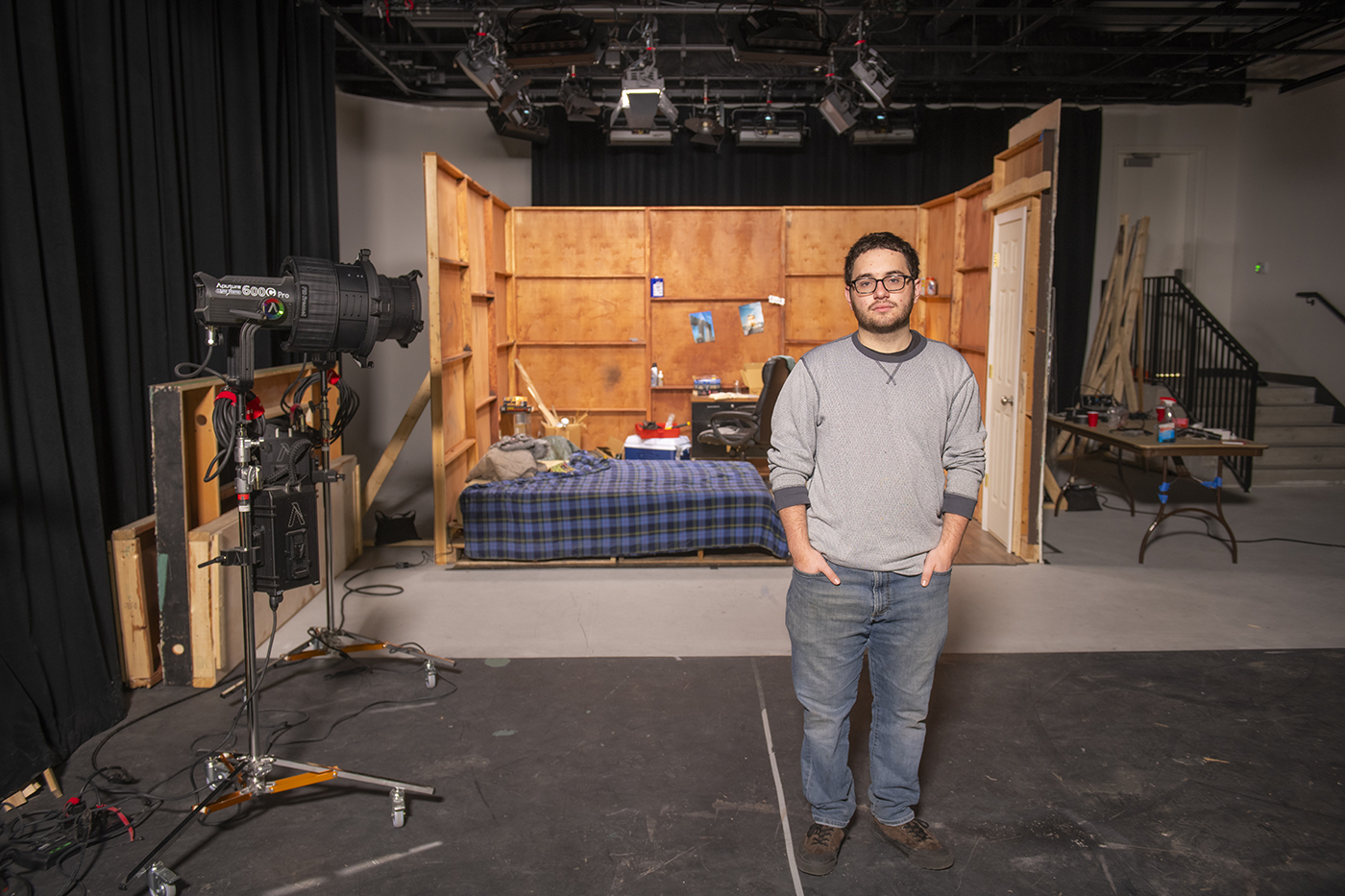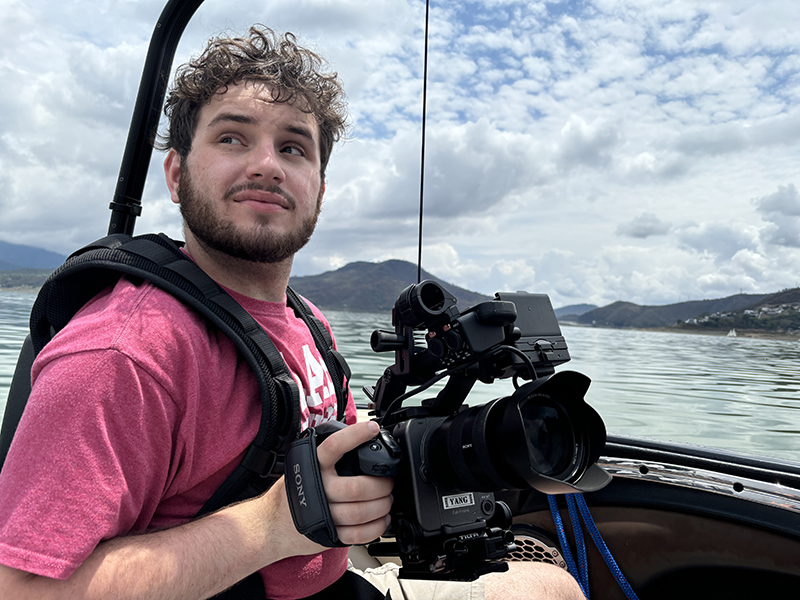Inside a cabin, will the fuse be lit?

Zeke Fairley with the structure he built for his upcoming short film. The cabin was inspired by that of Ted Kaczynski.
A man sits alone in a room, surrounded by items he deems essential to his life: a bed, a desk, a computer, books, a portable heater.
A bomb.
The device is wired to explode, when … if … the man chooses to detonate it. Whether he will flip that switch is the central conceit to the short film “Cabin Boy,” a meditation on male isolation, paranoia, and the demons — both the kind surging from within and those that course through a Wi-Fi connection— that leave a person pondering a hateful act. Written and directed by Zeke Fairley ’25 as his senior thesis, the film is set to begin production next month to be ready for a screening next May. Professor Soren Sorensen is his advisor on the project.
The screen studies major drew on several sources to shape the character of Dylan, a young man who desires “to make a big deal out of something.” Fairley began tinkering with the idea of a domestic terrorist-in-the-making during his sophomore year as he considered the lingering impact of the pandemic lockdown on people’s mental health. In the film, Dylan — restless and angry — is pondering whether he should stage a catastrophic attack. He nests in his room with his homemade explosive while giving voice to the dangerous thoughts pinging about his brain.
“He is cohabitating with this bomb — just present in the same place with it. This is about someone who is truly isolated,” he says.
Fairley explores the avenues the mind may travel if one is living in solitude while prowling the internet for ideologies that corrupt their better natures and indulge their most destructive impulses, yet also offer community with fellow adherents.
“If you’re around people talking about violence on some web forum, does that rub off on you?” he asks. “What happens when you start believing everything you read on the internet and come to the conclusion that you are the solution to the things that are wrong with the world — that you can change it all with some big move? These are the thoughts of a naïve young person.”

He notes the inherent conflict of desiring to live off the grid while also insisting on perpetual online connectivity. “What is ‘going off the grid’ when you’re addicted to the internet?” he wonders.
The look of the “Cabin Boy” set reaches back to the infamous case of Ted Kaczynski, the notorious Unabomber, who killed three people and injured 23 others between 1978 and 1995 in a nationwide mail-bombing campaign. Kaczynski staged his attacks from a remote cabin in Montana, targeting people he believed were advancing technologies and philosophies that threatened social norms and devastated the natural environment.
Fairley studied photos of the cabin’s interior that were taken after Kaczynski had been apprehended by authorities and set about replicating its appearance for his film. In a basement studio in the Center for Media Arts, Computing, and Design, he has reconstructed a strikingly similar cabin interior from plywood and furnished it to suggest a spartan lifestyle with a hoarder’s sensibility, from the frayed office chair to the stained carpet to the empty cans of hard cider and Pabst Blue Ribbon on the shelves. Fairley opened up the set for viewing by the Clark community during last Thursday’s ClarkFEST, the semesterly celebration of students’ intellectual and creative endeavors, where he gave visitors a tour and shared the genesis of the project that earned him a Steinbrecher Fellowship.
The interior scenes will be shot on that set; exteriors will be filmed next month at a Vermont cabin owned by a friend of Fairley’s.
The “Cabin Boy” screenplay features another key character, a postal worker named Jay (played by Clark sculpture professor James Maurelle) who unknowingly has been delivering the components of the bomb to Dylan (portrayed by Quinn Fay ’24). The plot tracks the evolving relationship between the men, and the repercussions when Dylan achieves a measure of notoriety. In a meta-twist, a local art museum wants to recreate the cabin as part of an exhibit. But Jay resists, insisting the details of Dylan’s story have been misrepresented to the public — a commentary, Fairley says, on the popular fascination with true-crime dramas.
Fairley aspires to a career behind the camera, citing the gritty films of the 1970s as among his favorites. (As he was being interviewed for this article inside Belén Casa de Pan, Fairley was approached by a Clark alum who’d been sitting at a nearby table. She acknowledged overhearing the conversation, handed him a list of film titles she’d scrawled on an index card — several of them from the ’70s — and gently insisted, “You need to see these.”)
Thanks to Clark, Fairley has had a strong start to realize his cinematic dream. He was among a group of Clark students who spent a portion of their summer filming in and around Mexico City to capture the stories of communities most impacted by climate change and water scarcity. The project, which was done in tandem with an ongoing Clark-led research study funded by the National Science Foundation, will culminate in a Spanish-language documentary about Mexico City’s water struggles.
In his own words, he feels “connected to the process” of making movies and, from the director’s chair, sees a clear opportunity to bring his creative vision to the screen. “I want to be able to communicate my ideas to crack this specific puzzle.”
Learn about screen studies at clark

